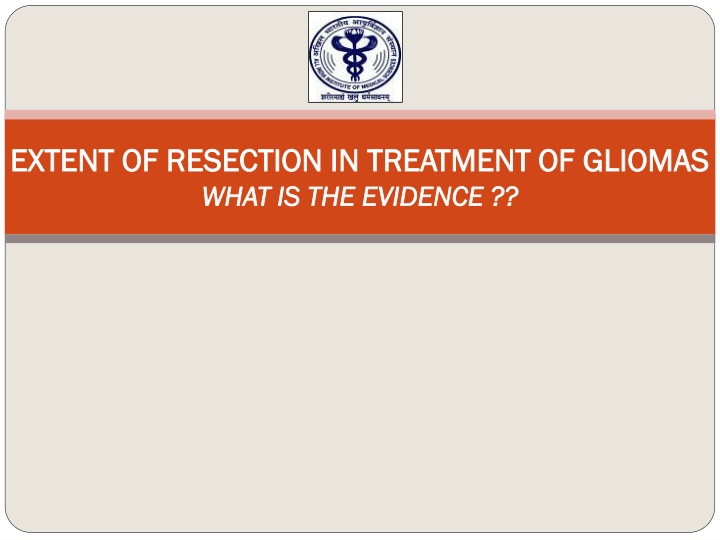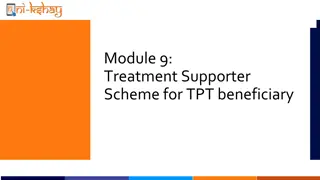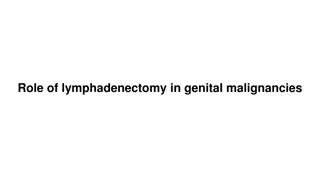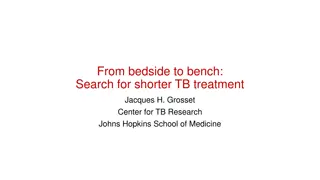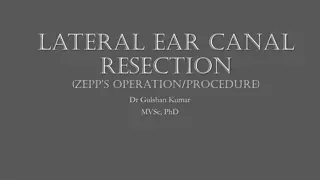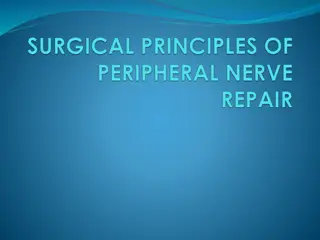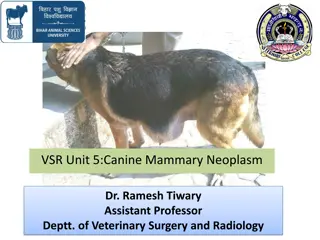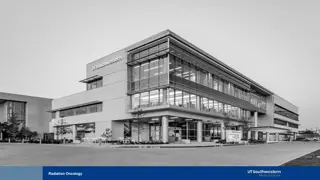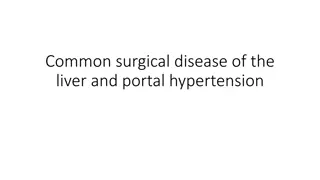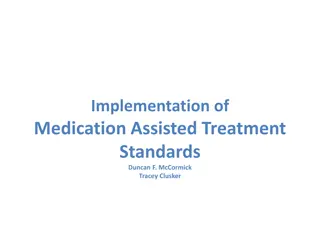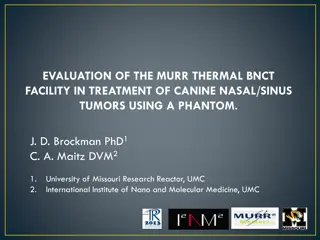Extent of Resection in Glioma Treatment: Evidence Overview
The debate on extent of resection in gliomas continues with conflicting evidence from studies like the Cochrane Database of Systematic Reviews and Level of Evidence analysis. Low-grade gliomas present specific challenges and characteristics. Understanding the evidence surrounding extent of resection is crucial for informed treatment decisions.
Download Presentation

Please find below an Image/Link to download the presentation.
The content on the website is provided AS IS for your information and personal use only. It may not be sold, licensed, or shared on other websites without obtaining consent from the author.If you encounter any issues during the download, it is possible that the publisher has removed the file from their server.
You are allowed to download the files provided on this website for personal or commercial use, subject to the condition that they are used lawfully. All files are the property of their respective owners.
The content on the website is provided AS IS for your information and personal use only. It may not be sold, licensed, or shared on other websites without obtaining consent from the author.
E N D
Presentation Transcript
EXTENT OF RESECTION IN TREATMENT OF GLIOMAS EXTENT OF RESECTION IN TREATMENT OF GLIOMAS WHAT IS THE EVIDENCE ?? WHAT IS THE EVIDENCE ??
EXTENT OF RESECTION OF GLIOMAS : THE DEBATE GTR vs. biopsy? Debulking vs. biopsy? GTR vs. near TR? GTR vs. GTR plus margin of normal tissue (lobectomy)? Only observation.
Hart MG, Grant R, Metcalfe SE . Cochrane Database of Systematic Reviews Cochrane Database of Systematic Reviews. Review content assessed as up-to-date: 4 January 2007. John Wiley & Sons, Ltd. The electronic database search yielded 2100 citations. Ten articles identified for possible inclusion however all failed to meet selection criteria and were excluded. 2- not RCTs but literature reviews, 3- prospective but assessed symptoms only, 1- RCT different CT regimens & subsequently analyzed according to the EOR, 4- RCTs but did not specifically compare biopsy v/s resection. One RCT of biopsy v/s resection in presumed malignant glioma was identified & discussed (Vuorinen V et al. Debulking or biopsy of malignant glioma in elderly people - a randomized study. Acta neurochirurgica 2003;145:5 10). Contained methodological shortcomings. Errors in trial design and under-powering, Findings tainted by high likelihood of being affected by bias and chance. Conclusion : it is of insufficient reliability to be used to influence treatment decisions.
Martin A. Proescholdt, Christine Macher, Chris Woertgen, Alexander Brawanski. Level of evidence in the literature concerning brain tumor resection. Level of evidence in the literature concerning brain tumor resection. Clinical Neurology and Neurosurgery. 2005; 107, 95-98. The level of evidence (LOE) classification was I: 0% II: 6.8% III: 65.7% IV: 27.5% 72.5% - observed positive effect of total tumor removal. 84.2% - did not report the criteria for treatment assignment. 62.5% did not define the terms gross total; radical; partial; or subtotal resection. To date,no studies with high LOE are available addressing the benefit of gross total brain tumor removal.Although the majority of the reports found a positive effect of radical resection, the reviewed articles contain methodological limitations which may significantly influence the results.
LOW GRADE GLIOMAS LOW GRADE GLIOMAS .the diffuse, infiltrating variety of tumors classified as WHO grade II lesions specifically, oligodendrogliomas,or mixed oligoastrocytomas. *1 Low-grade astrocytomas, the most common histological subtypes are the fibrillary,protoplasmic,and gemistocytic variants. 15% & 25% of brain tumors in adults & children respectively.*2 1500 new cases /yr dx in NorthAmerica.*3 Median age :adults 35 years & childhood 6 -12 years. Typically arise in frontal,temporal & parietal lobes.*4 low-grade astrocytomas, *1. Kleihues P, : Pathology and Genetics of Tumours of the Nervous System. Lyon, IARC Press, 2000. *2. Guthrie BL, Laws Jr ER: Supratentorial low-grade gliomas. Neurosurg Clin N Am 1990; 1:37-48. *3. Davis FG, Malinski N, Haenszel W, et al: Primary brain tumor incidence rates in four United States regions, 1985-1989: a pilot study. Neuroepidemiology 1996; 15:103-112. *4. McCormack BM, Miller DC, Budzilovich GN, et al: Treatment and survival of low-grade astrocytoma in adults 1977-1988. Neurosurgery 1992; 31:636-642.
LGG : THE CONTROVERSY LGG : THE CONTROVERSY Median survival : 6.5 - 8 years.*1 Published survival estimates : from 3 to > 20 years. 5- and 10-year survival rates : 70% and 50%, respectively. *2 Clinical course of individual LGGs - heterogeneous, with certain lesions tending to behave more aggressively. THUS THE CONTROVERSY: What is the most appropriate strategy for treating patients with LGG. ???? Observation Surgical intervention Biopsy : open / stereotactic Tumor resection : Extent Radiotherapy Chemotherapy *1. Johannesen TB et al: Progress in long-term survival in adult patients with supratentorial low-grade gliomas. J Neurosurg 2003; 99:854-862. *2. Leighton C et al: Supratentorial low-grade glioma in adults: an analysis of prognostic factors and timing of radiation. J Clin Oncol 1997; 15:1294-1301.
Prognostic factors : assigning LGG patients to Prognostic factors : assigning LGG patients to low low- - and high and high- -risk subgroups risk subgroups Improved survival outcomes Improved survival outcomes Poor survival outcomes Poor survival outcomes Max tm diameter >5 to 6 cm Presence of contrast enhancement. Age <40 years at diagnosis Seizures at diagnosis Absence of additional neurological deficits at diagmosis KPS score 70 MMSE score > 26/30. MIB-1 index < 8% Histology either low-grade ODG or oligoastrocytoma (esp. chromosome 1p deletions) Shaw E, et al: Prospective randomized trial of low- versus high-dose radiation therapy in adults with supratentorial low-grade glioma: initial report of a North Central Cancer Treatment Group/Radiation Therapy Oncology Group/Eastern Cooperative Oncology Group study. J Clin Oncol 2002; 20:2267-2276.
LGG : DEDIFFERENTIATION Also known as malignant transformation : well-described phenomenon. 13% to 86% of tumors initially dx LG were observed to recur at a higher histological grade. Time to malignant differentiation variable- (range 28 to 60 mths). Factors resulting in the transformation: unclear, and the effect of treatment on this malignant transformation remains controversial. Berger MS et al: The effect of extent of resection on recurrence in patients with low grade cerebral hemisphere gliomas. Cancer 1994; 74:1784-1791. Vertosick Jr FT et al: Survival of patients with well-differentiated astrocytomas diagnosed in the era of computed tomography. Neurosurgery 1991; 28:496-501.
LGG : OBSERVATION Uncommon for a patient with the clinical presentation and imaging characteristics of an LGG to be followed up with regular imaging unless a histological diagnosis is obtained at first presentation. Some still advocate this extremely conservative approach esp. deep- seated lesions or lesions located in eloquent cortex Advantage Defers treatment-related risk Defers treatment-related costs for patients who remain asymptomatic Disadvantage Increase the risk for tumor progression development of new neurological deficits or intractable seizures, Increases risk for malignant dedifferentiation of the lesion. Initial presumptive diagnosis may be incorrect.
Recht LD et al. Suspected low-grade glioma: is deferring treatment safe?. Ann Neurol 1992; 31:431-436. retrospective case-controlled study 58%of cases being observed only . eventually required surgery at a median interval of 29 months. 50% of the tumors then showed anaplastic features. Although they had a higher incidence of malignant transformation at the time of operation and shorter time to tumor progression relative to patients who were operated on initially .., the study concluded that no difference was observed in overall survival or QOL.
van Veelen ML et al: Supratentorial low grade astrocytoma: prognostic factors, dedifferentiation, and the issue of early versus late surgery. J Neurol Neurosurg Psychiatry 1998; 64:581-587. 30 patients presenting only with seizure early v/s late surgical resection did not affect overall survival. If observation is chosen, disease progression may be detected based on the onset of new neurological deficits, a change in seizure pattern or frequency, or simply an increase in lesion size or new contrast enhancement seen on MRI. However both studies were statistically weak as n < 50.
LGG : OBSERVATION Tumor growth rates can be unpredictable and are often nonlinear, leading to sudden changes in tumor size- can drastically change the surgical landscape turning an initially resectable or radio responsive lesion into one that is difficult to remove safely or is more resistant to adjuvant therapies. Psychological stress associated with not knowing with certainty : increased distress and reduced quality of life for both the patient and the caregiver. Little evidence exists to support this treatment strategy, although it has not been refuted, either.
SURGICAL INTERVENTION Choice of procedure depends on patient's clinical status anatomic location surgeon's preference Goals of surgical intervention establishing a diagnosis treating neurological symptoms decompressing mass effect tumor cytoreduction. Currently, the only agreed-on surgical standard for adults with suspected or known supratentorial non optic-pathway LGGs is to obtain a tissue diagnosis before active treatment commences. Practice parameters in adults with suspected or known supratentorial nonoptic pathway low-grade glioma. Neurosurg Focus 1998; 4:e10.
LGG : Biopsy Stereotactic or image-guided. Minimally invasive : Tissue for histological diagnosis. Advantage Suitable if open surgical resection is declined, deferred, or carries unacceptably high risks. Identification of patients harboring more aggressive lesions, for which a course of observation alone may be inappropriate.*1 Tissue can be analyzed for oligodendroglial characteristics, such as chromosome 1p loss. Surgical risks Low- morbidity and mortality rates <1%. *2 Mortality ICH, SAH or uncontrollable cerebral edema, Generally observed only among biopsies of high-grade lesions.*3 *1. Lunsford LD et al: Brain astrocytomas: biopsy, then irradiation. Clin Neurosurg 1995; 42:464-479. *2. Lunsford LD et al: Survival after stereotactic biopsy and irradiation of cerebral nonanaplastic, nonpilocytic astrocytoma. JNS 1995; 82:523-529. *3. Bernstein M, Parrent AG: Complications of CT-guided stereotactic biopsy of intra-axial brain lesions. J Neurosurg 1994; 81:165-168
LGG : Biopsy Disadvantage: Possibility of misdiagnosis or inaccurate tumor grading Tumor heterogeneity Diagnosis bias resulting from limited tumor sampling. The concordance between biopsy and open resection specimens is lower in patients with larger tumors, suggesting that multiple biopsies, which can be collected in a single trajectory pass, may be useful in this subpopulation . * Diagnostic accuracy may be improved by Specific regional targeting of the biopsy site within the tumor mass. Including the enhancing regions of initial scan in the biopsy. Complicated - HG lesions may not always show contrast enhancement. Preoperative planning of biopsy targets based on physiologic imaging modalities (e.g., PET, SPECT, MRS) may increase the certainty of sampling the most aggressive portion of a particular tumor. * Woodworth GF, McGirt MJ, Samdani A, et al: Frameless image-guided stereotactic brain biopsy procedure: diagnostic yield, surgical morbidity, and comparison with the frame-based technique. J Neurosurg 2006; 104:233-237.
Douglas Kondziolka, L. Dade Lunsford, A. Julio Martinez. Unreliability of contemporary neurodiagnostic imaging in evaluating suspected adult supratentorial (low-grade) astrocytoma. Journal of Neurosurgery 1993; 79:533-536 N=20 young (mean age 37 years), all lobar lesions: CT/MRI s/o LGG Histological diagnosis (Biopsy) : without morbidity. Only 10 (50%) had low-grade astrocytomas, whereas 9 (45%) had anaplastic astrocytomas and 1 (5%) had encephalitis. Conclusion: Modern high-resolution neuroimaging alone cannot be used as a reliable tool to predict the histological diagnosis of astrocytoma (50% false-positive rate). All patients with supratentorial SOL exhibiting typical imaging features of astrocytoma should undergo stereotactic biopsy for confirmation. Barker et al. (UCSF), Cancer 1997 Nonenhancing tumors are not always low-grade. Chance of anaplasia increases in older patients (50% by mid-40 s)
Providing a diagnosis? Bx/ resection Glantz et al., Influence of the type of surgery on the histological diagnosis in patients with anaplastic gliomas Neurology, 1991 vol. 41 no. 11 1741 More extensive resections more frequently provide higher grade diagnosis
Providing a diagnosis ? Providing a diagnosis ? Bx Identification of oligo component in Gr 3 tumors was more likely as EOR Bx v/s resection v/s resection Perry et al., Cancer 1999 % containing oligo components: (p = 0.01) Bx 3% STR 29% GTR 43% Carter et al., SEER data % containing oligo components: (more specimens -> more oligo) Bx 32% Resection 62% p < 0.001
LGG: Surgical Resection Role is well established in patients with accessible LGG who have symptoms of local mass effect increased intracranial pressure intractable seizures Resection serves several purposes in these circumstances alleviation of mass effect cytoreduction providing tissue for diagnosis Cytoreduction: can also reduce cerebral edema and potentially improve radio sensitivity and chemo sensitivity. The degree of tumor removal .. offers the advantage of providing more tissue for histological analysis, increasing the accuracy of pathologic diagnosis. .also reduces the number of tumor cells at risk for accumulating additional genetic aberrations, thereby reducing the risk for tumor progression and decreasing the potential for malignant transformation . * * Smith JS, Chang EF, Lamborn KR, et al: Role of extent of resection in the long-term outcome of low-grade hemispheric gliomas. J Clin Oncol 2008; 26:1338-1345.
Chang EF, Potts MB, Keles GE, et al: Seizure characteristics and control following resection in 332 patients with low-grade gliomas. J Neurosurg 2008; 108:227-235. Department of Neurological Surgery & Brain Tumor Research Center, University of California, San Francisco, California Retrospective study - Seizures in 81% cases 50% had uncontrolled seizures at the time of resection despite antiepileptic Rx. Postoperative : 90% were seizure free or had meaningful improvement. Surgical resection : effective means of reducing seizure burden. Factors associated with post-op freedom from seizures: Gross total tumor resection Preoperative seizure history of < 1 year Non simple partial seizure type.
LGG: Surgical Resection Contemporary neurosurgical methods: USG, functional mapping, frameless navigational, and intraoperative imaging - more extensive resections with less morbidity. Intraoperative USG: real-time intraoperative data, helpful in detecting the tumor, delineating its margins, and differentiating tumor from peritumoral edema, cyst, necrosis, and adjacent normal brain tissue. use is limited by artifact from blood and surgical trauma at the margin of resection, post resection tumor volumes based on intraoperative ultrasonography significantly correlate with those determined by postoperative MRI.*1 Intraoperative MRI: may allow for greater extent of resection, particularly when tumor-infiltrated tissue cannot be grossly distinguished from normal tissue.*2 *1. Hammoud MA et al: Use of intraoperative ultrasound for localizing tumors and determining the extent of resection: a comparative study with magnetic resonance imaging. JNS 1996; 84:737-741. *2. Claus EB et al: Survival rates in patients with low-grade glioma after intraoperative MRI guidance. Cancer 2005; 103:1227-1233.
LGG: Surgical Resection Sanai N, Mirzadeh Z, Berger MS: Functional outcome after language mapping for glioma resection. N Engl J Med 2008; 358:18-27. Stimulation mapping techniques: minimize morbidity allows radical resections of tumors located in or around cortical and subcortical functionally eloquent sites For lesions in and around language pathways, awake mapping remains the gold standard for minimizing morbidity and maximizing extent of resection. Intraoperative corticography - useful adjunct, but it is primarily reserved for patients with intractable epilepsy.
LGG: Surgical Resection Role for surgery in minimally symptomatic or asymptomatic lesions remains controversial. Historical debate: whether the extent of resection actually confers any survival advantage for these patients ?? Recent body of evidence suggests that more extensive resection at the time of initial diagnosis is a favorable prognostic factor. .Although most reports are retrospective, it is unlikely that the necessary prospective randomized studies will be conducted to address the role of extent of resection on outcome in LGG patients owing to the relatively limited numbers of patients, the typically long survival times, and a general lack of equipoise with regard to treatment options among care providers . Smith JS, Chang EF, Lamborn KR, et al: Role of extent of resection in the long-term outcome of low-grade hemispheric gliomas. J Clin Oncol 2008; 26:1338-1345.
Smith JS et al: Role of extent of resection in the long-term outcome of low-grade hemispheric gliomas. Depart of N Surgery, Brain Tumor Research Center, University of California, San Francisco, CA. J Clin Oncol 2008; 26:1338-1345. N= 216, retrospective study VOLUMETRIC EXTENT OF RESECTION ANALYSIS Extent of resection 8-yr overall survival Progression free survival 43 % 91 % 90% < 90 % 60 % 21 % EOR was a significant predictor of overall survival and showed a trend toward predicting progression-free survival.
Smith JS et al: Role of extent of resection in the long-term outcome of low-grade hemispheric gliomas. J Clin Oncol 2008; 26:1338-1345. A. Larger preop tumor volumes have significantly shorter progression- free survival times (P < .001). B. Complete resection of FLAIR imaging abnormality (75 patients, 2 events) had a significantly longer overall survival time v/s having any residual (141 patients, 32 events) (P = .001). C. Even small volumes of residual FLAIR abnormality demonstrated shorter overall survival times v/s no residual FLAIR abnormality . (P = .001). D. Patients with a greater percentage of tumor resection had a significantly longer overall survival interval (P < .001).
Evidence in literature In the modern neurosurgical era many studies have applied statistical analysis to examine the efficacy of EOR in improving survival and delaying tumor progression among LGG patients. Five - included volumetric analysis of extent of resection Those not employing volumetric methods: 12 demonstrated evidence supporting EOR as a statistically significant predictor of either 5-yr survival or 5-yr progression free survival. Published from 1990 to 2005 Employed combination of multivariate and univariate analyses. Recent volumetric LGG EOR analysis, Smith et al 2008 more aggressive resection does predict significant improvement in overall survival compared with a simple debulking procedure. predicted overall survival affected by residual tumor volumes as small as 10 cm3
Sanai et al. Neurosurgery 2008. Non-volumetric LGG EOR studies in modern literature 5-year prog-free survival rate 5-year survival rate 5-Yr Prog free survival % Univar F value Multivar F val 5 Yr Univar F value Multivar F val STUDY NO. of cases 179 EOR (n) survival % GTR 45 STR 95 BX 39 NA NA NA 80 50 45 .0002 <.01 Phillipon et al , 1993 GTR 45 STR 95 PR 22 BX 39 NA NA NA 90 52 50 42 <.05 NS 82 Rajan et al GTR 85 STR 23 NA NA NA 82 64 .008 .006 167 Leighton et al, 1997 Rad 43 N Rad 45 NA NA NA NA <.001 <.001 88 Nakamura et al, 2000 GTR 45 STR 95 BX 39 GTR 173 STR 689 BX 131 NA 0.0137 NS 88 56 71 .0116 .0349 203 Shaw et al, 2002 NA NA NA NA 993 NS NS Johannesen et al, 2003
Sanai et al. Neurosurgery 2008. Volumetric LGG EOR studies in modern literature 5-year prog-free survival rate 5-year survival rate 5-Yr Prog free survival % Univar Fvalue Multivar F val 5 Yr Univar Fvalue Multivar F val STUDY NO. of cases 90 EOR % (n) survival % > 75 (13) NA NA NA 62 .0002 .04 Van Veelen et al , 1998 < 75 (59) 18 100 (56) NA NA NA 98.2 .05 <.05 156 Claus et al, 2005 <100 (100) 92.0 0-40 (21) 41-69 (39) 70-89 (55) 90-99 (26) 100 (75) NA NA NA 75.5 78.0 NA .005 NA NA NA 97.0 98.0 NA <.001 216 Smith et al, 2008
mounting evidence in the modern neurosurgical literature suggests that a more extensive surgical resection may be associated with a more favorable life expectancy for LGG patients. Sanai N, Berger MS.: Glioma extent of resection and its impact on patient outcome. Neurosurgery 2008; 62:753-764. More aggressive resections for low-grade gliomas also affect the risk for malignant transformation, . they take advantage of an opportunity to treat the disease when the neoplasm is at its earliest stage of evolution. Smith JS, Chang EF, Lamborn KR, et al: Role of extent of resection in the long-term outcome of low-grade hemispheric gliomas. J Clin Oncol 2008; 26:1338-1345.
LGG : CONCLUSIONS LGG : CONCLUSIONS Although more indolent than their high-grade counterparts, their associated clinical course is by no means benign. To delay the inevitable progression toward malignancy, aggressive LGG resection is supported by a growing body of literature and can improve patient outcome, but it should not be pursued at the expense of a patient's quality of life. Such a strategy minimizes the chances of misdiagnosis from sampling error and can immediately relieve symptomatic mass effect, obstructive hydrocephalus, and neurological deficit. Greater extent of resection is also correlated with improved survival time and reduces the risk for malignant transformation. This necessitates precise delineation of the structural and functional tumor margins using a combination of preoperative imaging modalities, intraoperative mapping techniques, and functional mapping. Conservative therapy or observation is not recommended at this time. RT should be withheld until progression occurs, although CT agents such as TMZ may be useful as an upfront treatment.
Malignant Astrocytomas The most common malignant primary CNS tumors in adults.*1 Include Anaplastic astrocytoma (AA, WHO grade III) Glioblastoma multiforme (GBM, WHO grade IV) Gliosarcoma Even with optimal treatment, median survival .*2,*3 < 2 years for GBM 2 to 5 years for AA *1. DeAngelis LM: Brain tumors. N Engl J Med 2001; 344:114-123. *2. Souhami L, Seiferheld W, Brachman D, et al: report of Radiation Therapy Oncology Group 93-05 protocol. Int J Radiat Oncol Biol Phys 2004; 60:853-860. *3. Wen PY, Kesari S: Malignant gliomas in adults. N Engl J Med 2008; 359:492-507.
Malignant Astrocytomas Characterized by - invasive and infiltrative nature, making curative resection unlikely.1 1930s- Walter Dandy reported recurrence of contralateral gliomas even after hemispherectomy of the tumor-bearing hemisphere.2 1.Claes A, Idema AJ, Wesseling P: Diffuse glioma growth: a guerilla war. Acta Neuropathol (Berl) 2007; 114:443-458. 2. Dandy WE: Removal of right cerebral hemispheres for certain tumors with hemiplegia: preliminary report. JAMA 1928; 90:823-825. Often occur in the cerebral hemispheres * Can arise from low-grade astrocytoma (WHO grade II) Can also be dx de novo at first biopsy: without signs of a malignant precursor. AA has an innate tendency to progress to GBM. Both recur locally, often at the margins & even after GTR** *Keihus P et al: Anaplastic Astrocytoma. Pathology and Genetics of Tumors of the Nervous System, WHO Classification of Tumours, Lyon: IARC Press; 2000. **Wrensch M et al: Neuro Oncol 2002; 4:278-299.
MALIGNANT GLIOMAS:PROBLEM OF INVASION MALIGNANT GLIOMAS:PROBLEM OF INVASION Lethal ? grow by invasion, limiting the efficacy of surgery and other Rx. *1 Malignant glioma cells - great motility in both in vitro and in vivo rodent models.*2 Autopsy studies - HGG *3 extend beyond a single carotid or vertebral artery distribution often spread through the CSF pathways may extend past the 2-cm margins demonstrated by CT or MRI. Frequently microsatellites - scattered throughout normal brain tissue*4 Infiltration of eloquent areas : may limit the extent of tumor resection. Stereotactic biopsy samples distant from enhancing tumor contain tumor cells grossly / vitro culture techniques *5 Thus, imaging techniques and histology have limited resolution in estimating the true extent of tumor cell invasion and thus inevitably underestimate the true extent of these tumors *1. Burger PC et al: J Neurosurg 1988; 68:698-704. *2 . Bernstein JJ. J Neurosci Res 1989; 22:134-143. *3. Kelly PJ. J Neurosurg 1987; 66:865-874. *4 Salazar OM. Int J Radiat Oncol Biol Phys 1976; 1:627-637. *5 Silbergeld DL. J Neurosurg 1997; 86:525-531.
SURGERY FOR MALIGNANT GLIOMAS Goals of surgery (1) obtain a tissue diagnosis Rx recommendations can be made and prognosis can be assessed. (2) decrease the mass effect improve the patient's signs and symptoms lessen steroid dependence even prevent early death from progressive mass effect. (3) reduce the tumor burden.
SURGERY FOR MALIGNANT GLIOMAS GTR for many solid organ malignant tumors with clear surgical margins is associated with extended survival but for malignant astrocytoma is less clear . *1 At best, 99% resection (a 2-log kill) can be achieved.*2 Remaining 1% is sufficient for these tumors to recur. Extensive resection of malignant astrocytomas is difficult Invasive, widely infiltrative and often involve eloquent areas. *1. Barker 2nd FG. J Neurosurg 1996; 84:442-448 *2. Claes A. Acta Neuropathol (Berl) 2007; 114:443-458.
HGG : EXTENT OF RESECTION (EOR) Unclear whether the EOR of HGG is associated with improved survival. *1 Recurrence of malignant astrocytomas commonly occurs close to the tumor margin.*2 Extensive resection - theoretically decreases the number of remaining cells, renders the decreased tumor burden more responsive to adjuvant therapy, and potentially prolongs survival. *3,4 *1. Hess KR. J Neurooncol 1999; 42:227-231. *2. Sneed PK. Int J Radiat Oncol Biol Phys 1994; 29:719-727 *3. Chang SM et al. JAMA 2005; 293:557-564. *4. Keles GE et al. J Neurosurg 2006; 105:34-40.
Influence of Extent of Resection of HGG on Clinical Outcomes Influence of Extent of Resection of HGG on Clinical Outcomes Four systematic reviews of the literature Hess KR: Extent of resection as a prognostic variable in the treatment of gliomas. J Neurooncol 1999; 42:227-231. Nazzaro JM, Neuwelt EA: The role of surgery in the management of supratentorial intermediate and high-grade astrocytomas in adults. J Neurosurg 1990; 73:331-344. Grant R, Metcalfe SE: Biopsy versus resection for malignant glioma. Cochrane Database Syst Rev 2005; 2:CD002034 Quigley MR, Maroon JC: The relationship between survival and the extent of the resection in patients with supratentorial malignant gliomas. Neurosurgery 1991; 29:385-388.
Systematic reviews of the literature Systematic reviews of the literature LIMITED Did not control for confounding variables Were often underpowered Included biopsies in their analyses Frequently included studies conducted before 1990 Did not adjust for resectability and post-op treatment CONCLUDED the lack of good scientific evidence precludes any definitive statement on the effect of extensive resection on survival of patients with malignant astrocytoma.
Lacroix M et al: JNS 2001; 95:190-198. A multivariate analysis of 416 patients with GBM : prognosis, extent of resection, and survival. Resections > 98% - significantly associated with improved survival. Limitations 44% of the patients were previously Rx at other institutions. Adjuvant therapy was not included in the survival analysis.
McGirt MJ, et al: Independent association of extent of resection with survival in pts with malignant astrocytoma. JNS 2009; 110:156-162. Retrospectively reviewed the cases of 1215 patients Single institution from 1996 to 2006. Deep-seated or unresectable lesions were excluded. Mean age & KPS : 51 16 years and 80 10 respectively. Surgery: 10 resection in 549 patients (58%) and revision for recurrence in 400 patients (42%). WHO Grade IV in 700 patients (74%) and Grade III in 249 (26%). 167 astrocytomas and 82 mixed oligoastrocytoma. GTR, NTR, and STR - achieved in 330 (35%), 388 (41%), and 231 cases (24%), respectively
MRI < 48 HOURS OF RESECTION: GTR- no residual enhancement on MRI NTR - rim enhancement of resection cavity STR- residual nodular enhancement Estimated Kaplan-Meier plot of survival (mixed oligoastrocytoma excluded). Both GTR & NTR a/w survival benefit v/s STR. GTR versus NTR was not associated with improved survival. Median survival : After GTR, NTR, or STR, was 58, 46, and 34 months, respectively. Five-year survival rates : GTR, NTR, and STR were 42%, 41%, and 12%, respectively. McGirt MJ, Chaichana KL, Gathinji M, et al. Independent association of extent of resection with survival in patients with malignant brain astrocytoma. JNS. 2009;110:156-162.
EOR FOR GBM For both 10 & 20 resection: NTR - independent survival benefit compared with STR. (P < .002) GTR - independent survival benefit compared with NTR. (P < .05) After 10 GBM resection, median survival after GTR, NTR, or STR was 13, 11, and 8 months. For revision of recurrent GBM, median survival after GTR, NTR, and STR was 11, 9, and 5 months from the time of revision surgery. McGirt et al. JNS. 2009;110:156-162
Variables Variables a/w a/w overall survival after 1 overall survival after 10 0 resection of GBM resection of GBM Independently associated with improved overall survival. Decreasing age Increasing KPS increasing extent of resection Gliadel wafer temozolomide subsequent resection of late recurrence GTR / NTR - independent survival benefit compared with STR independent of disability or subsequent treatment modalities. McGirt et al. JNS. 2009;110:156-162
Variables Variables a/w a/w overall survival after revision resection of GBM overall survival after revision resection of GBM Independently associated with improved overall survival. Decreasing age Increasing KPS increasing extent of resection temozolomide subsequent resection of late recurrence GTR / NTR - independent survival benefit compared with STR independent of disability or subsequent treatment modalities. McGirt et al. JNS. 2009;110:156-162
Benefits of extensive resection Lower tumor load : increase the efficacy of adjuvant CT/ RT in killing the remaining cancer cells and increasing survival. *1,2 Secondary benefits. Increased relief of symptoms and neurological improvement.*3 *1. Pelloski CE. J Clin Oncol 2007; 25:2288-2294. *2. Friedman HS. J Clin Oncol 2000; 18:3522-3528. *3. Nakamizo A.Cancer Res 2005; 65:3307-3318.
Barker et al. Neurosurgery 49:1288, 2001 Is response to postoperative adjuvant radiation in newly-diagnosed glioblastoma improved by prior resection? N =301 (GBM) prospective study. More extensive surgical resection predicted better imaging- assessed response to postop adjuvant radiation in both univariate and multivariate analyses (adjusted for age, KPS) Martin J. van den Benta et al . EUROPEAN JOURNAL OF CANCER. 42 (2006) 582 8 Resection and TMZ EORTC 26981 (Stupp) GTR STR Bx 2-year survival median survival +TMZ -TMZ +TMZ -TMZ 37% 14% 18m 23% 9% 14m 10% 5% 9m 14m 12m 8m
McGirt MJ et al. Gliadel (BCNU) wafer plus concomitant temozolomide therapy after primary resection of GBM J Neurosurg 2009; 110:583-588. n=147 multimodality treatment involving radiation therapy, temozolomide, and intraoperative placement of Gliadel resulted in the longest mean survival time of 20 months
Conclusions : HGG Conclusions : HGG Prognosis for HGG is poor. Management typically consists of surgery followed by RT + CT. Even after extensive treatment, residual tumor is inevitable and patients eventually succumb to this disease. Age and KPS score are the most significant prognostic factors.*1 Individual patient survival is heterogeneous, with some long- term survivors. Hence all out sincere efforts to be made . *2 *1 McGirt et al. JNS. 2009;110:156-162 *2 Dehdashti AR et al: Can J Neurol Sci 2007; 34:339-342.
Conclusions : HGG Conclusions : HGG No evidence based recommendations as to the best surgical management of patients with malignant glioma can be made. Until there is concrete evidence one way or the other, it is important to consider each case individually and for the surgeon to carry out the procedure which he deems to be the most appropriate for that particular patient, taking into account the risks and benefits. Such decisions are best made at a multi-disciplinary team meeting (NICE guidance) . Given the lack of trial-based evidence, individual clinicians should be encouraged to enter their patients into a controlled clinical trial, if such a trial were to be established in the future. Hart MG, Grant R, Metcalfe SE . Cochrane Database of Systematic Reviews. Review content assessed as up-to-date: 4 January 2007. JohnWiley & Sons, Ltd.
? How will you manage a case of low grade glioma (Grade II) whose post-operative MRI on day 1 or 2 shows a small residual tumor ??
